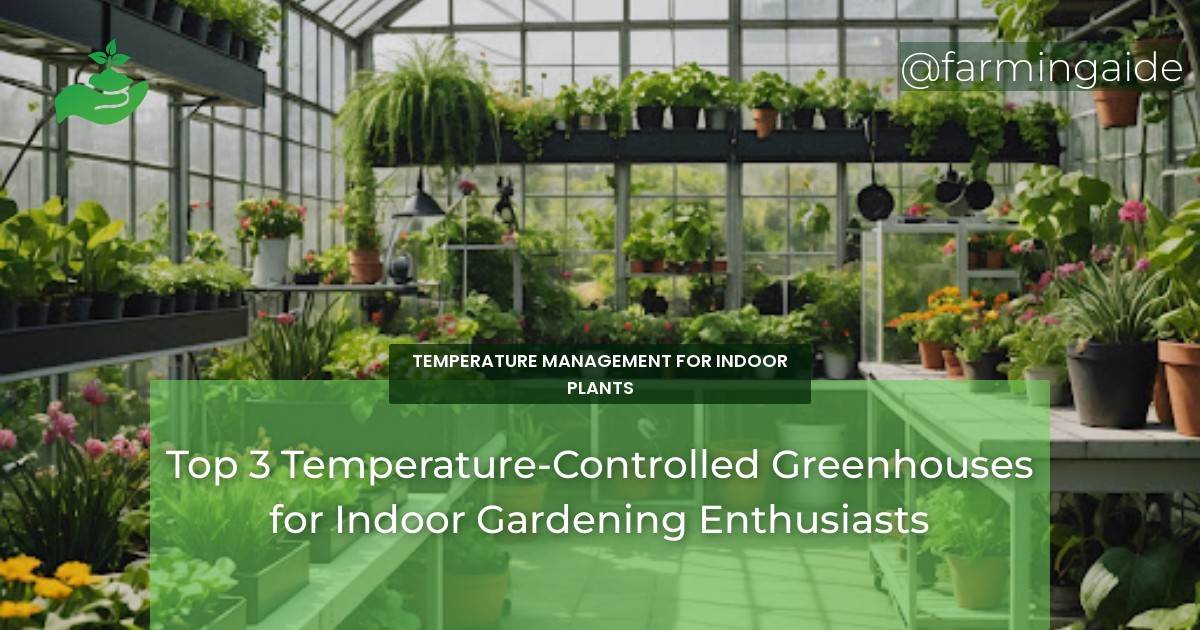Are you an indoor gardening enthusiast looking to take your hobby to the next level? Temperature-controlled greenhouses are the perfect solution for you! These innovative structures provide the ideal environment for your plants to thrive, regardless of the outside weather conditions. In this article, we’ll explore the top 3 temperature-controlled greenhouses for indoor gardening enthusiasts, highlighting their features, benefits, and maintenance tips.
Key Takeaways
- Temperature-controlled greenhouses provide optimal growing conditions for indoor plants.
- Features to consider when selecting a greenhouse include temperature range, size, and accessories.
- Regular maintenance is crucial for the longevity and performance of your greenhouse.
- A comparison of top greenhouses can help you make an informed purchasing decision.
- Future trends in temperature-controlled greenhouses include sustainable materials and smart technology.
Introduction to Temperature-Controlled Greenhouses
Temperature-controlled greenhouses are specifically designed to provide a stable and optimal growing environment for plants. These structures are equipped with advanced climate control systems, allowing you to regulate temperature, humidity, and light levels to suit your plants’ needs.
By controlling the temperature, you can extend the growing season, protect your plants from extreme weather conditions, and create an ideal environment for optimal growth and development.
Benefits of Temperature-Controlled Greenhouses
Temperature-controlled greenhouses offer numerous benefits for indoor gardening enthusiasts. Some of the most significant advantages include:
Year-round growing: With a temperature-controlled greenhouse, you can grow plants 365 days a year, regardless of the outside weather conditions.
Key Features to Consider
When selecting a temperature-controlled greenhouse, there are several key features to consider:
Temperature range: Look for a greenhouse that can maintain a temperature range suitable for your plants’ needs.
Review of Top 3 Temperature-Controlled Greenhouses
After researching and comparing various temperature-controlled greenhouses, we’ve narrowed down the top 3 options for indoor gardening enthusiasts.
ALSO READ
Greenhouse A: Features and Specifications
Greenhouse A is a popular choice among indoor gardening enthusiasts. This greenhouse features:
A temperature range of 40°F to 90°F (4°C to 32°C).
A spacious interior with a size of 8×10 feet (2.4×3 meters).
Advanced climate control system with automated temperature and humidity regulation.
Greenhouse B: Features and Specifications
Greenhouse B is another top contender for indoor gardening enthusiasts. This greenhouse features:
A temperature range of 35°F to 95°F (2°C to 35°C).
A compact design with a size of 6×8 feet (1.8×2.4 meters).
Energy-efficient design with a high level of insulation.
ALSO READ
Greenhouse C: Features and Specifications
Greenhouse C is a premium option for indoor gardening enthusiasts. This greenhouse features:
A temperature range of 30°F to 100°F (-1°C to 38°C).
A spacious interior with a size of 10×12 feet (3×3.6 meters).
Advanced LED lighting system for optimal plant growth.
Comparison and Selection Guide
When selecting the right temperature-controlled greenhouse for your needs, consider the following factors:
Cost Comparison
The cost of temperature-controlled greenhouses varies significantly, depending on the size, features, and brand. Here’s a comparison of the top 3 greenhouses:
| Greenhouse | Price Range |
|---|---|
| Greenhouse A | $1,500 – $2,500 |
| Greenhouse B | $1,000 – $2,000 |
| Greenhouse C | $3,000 – $5,000 |
Space and Capacity
Consider the size of the greenhouse and its capacity to accommodate your plants:
| Greenhouse | Size (ft) | Capacity (plants) |
|---|---|---|
| Greenhouse A | 8×10 | 20-30 plants |
| Greenhouse B | 6×8 | 10-20 plants |
| Greenhouse C | 10×12 | 30-50 plants |
Additional Features and Accessories
Consider the additional features and accessories offered with each greenhouse:
Greenhouse A: Automatic irrigation system and built-in trellis.
Greenhouse B: Energy-efficient design and high-level insulation.
Greenhouse C: Advanced LED lighting system and precision temperature control.
Installation and Maintenance Tips
Proper installation and regular maintenance are crucial for the longevity and performance of your temperature-controlled greenhouse.
Installation Process
Follow these steps to ensure a successful installation:
Choose a flat and level surface for the greenhouse.
Assemble the structure according to the manufacturer’s instructions.
Regular Maintenance
Regular maintenance is essential to ensure the optimal performance of your greenhouse:
Check the temperature and humidity levels regularly.
Clean the greenhouse regularly to prevent the buildup of dirt and debris.
Troubleshooting Common Issues
Common issues with temperature-controlled greenhouses include:
Temperature fluctuations: Check the thermostat and temperature sensors for proper function.
Humidity issues: Check the humidistat and ensure proper ventilation.
How Can I Apply Temperature Management Techniques in a Greenhouse for Indoor Plants?
When it comes to maintaining an optimal environment for indoor plants in a greenhouse, implementing temperature management tips is crucial. This can involve using ventilation systems, shading materials, and proper insulation to regulate temperature and ensure the well-being of your plants. Monitoring and adjusting temperatures regularly is also important for plant growth.
How Can I Use Temperature and Humidity Control in a Greenhouse for Indoor Plants?
When it comes to maintaining optimal conditions for indoor plant climate control in a greenhouse, temperature and humidity are key factors. Using proper ventilation and shading, as well as utilizing misting systems and water management, can help create the ideal environment for the healthy growth of indoor plants.
What are the best ways to monitor and control temperature fluctuations for indoor plants in a non-controlled environment?
Monitoring indoor plant temperature is crucial for maintaining a healthy environment for your indoor plants. Utilizing a digital thermometer with a remote sensor can help you keep track of temperature fluctuations. Additionally, investing in a smart thermostat can allow you to control the temperature remotely, ensuring optimal growing conditions for your plants.
Conclusion and Recommendation
In conclusion, temperature-controlled greenhouses offer a superior growing environment for indoor gardening enthusiasts. By considering the top 3 greenhouses reviewed in this article, you can make an informed decision for your specific needs.
Final Thoughts on the Best Greenhouse for Your Needs
When selecting a temperature-controlled greenhouse, consider your specific needs, budget, and the features that matter most to you.
Future Trends in Temperature-Controlled Greenhouses
Future trends in temperature-controlled greenhouses include the use of sustainable materials, smart technology, and energy-efficient designs.


